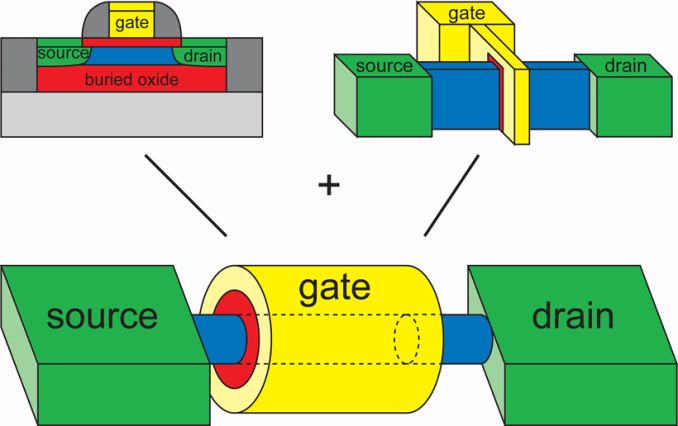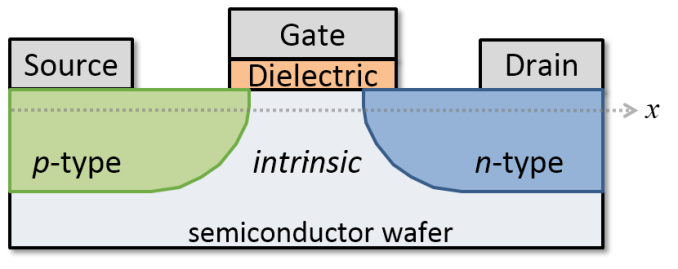An Introduction to Semiconductor Physics, Technology, and Industry
by Joshua Ho on October 9, 2014 3:00 PM EST- Posted in
- Semiconductors
- CMOS
- Physics
- Industry
- Technology
Improving Transistor Performance
While it's impossible to predict what the future will hold, it's relatively easy to see what trends will take place in the near future to keep Moore's law alive. For example, instead of using dual or tri gate technologies (FinFET), it's reasonable to expect that gate-all-around (GAA) will become the next step in the evolution of transistor shapes. However, it's currently not clear when this would reach mass production, if ever.
Currently, experimental GAAFETs have only existed for around eight years. For reference, FinFETs were first made in 1999. It took around a decade and a half for any such 3D transistor to reach mass production. By continuing to scale to higher k dielectrics for the gate, lower k dielectrics between interconnects, lower resistance metals for interconnects, and even better strain engineering, we will continue to see the scaling of CMOS technology.
CNFET / Joerg Appenzeller
Unfortunately, all of these can only go so far. Fundamentally, there will be a point where silicon-based transistors cannot scale any further. Gate oxides, channel lengths, and other critical dimensions can only shrink so much before either resistance is too high or a myriad of other effects render smaller sizes infeasible.
The next step is almost impossible to predict. Perhaps graphene will take the place of silicon, but graphene currently is impossible to mass-produce and is a semi-metal, which means that it inherently lacks a band gap, although it's possible to create one. While it's been shown that semi-metal transistor logic is possible, it's currently in the very early stages and Boolean logic may be impossible with graphene. Phosphorene has promise as a semiconductor replacement for silicon, but it's similarly impossible to mass produce. Phosphorene-based FETs are still in the exploratory stages, with no actual transistor created yet.
TFET Lateral Structure / Jteherani / CC BY SA
Outside of material changes, the working mechanism of the transistor itself may change. One promising candidate right now is the tunnel field effect transistor, which relies on band to band tunneling rather than the traditional inversion layer generation for current flow. This is similar to leakage that occurs from halo doping, which results from the conduction band of the channel material aligning with the valence band of the source or drain material. As seen by the photo above, this type of transistor has an undoped body and the source/drain are of opposing types. The gate structure is unchanged from previous MOSFETs. In practice, such a transistor structure has a much higher rate of current increase per unit of voltage.
Final Words
It's been a long road, but let's quickly go over the topics covered in this article. We started with a description of semiconductor physics, then moved to the basics of MOSFETs and CMOS. Once we understood how MOSFETs work in CMOS to create logic, we moved on to the actual fabrication process of these transistors in a chip.
After all of this, we discussed how companies have increased the resolution of the fabrication process to make ever smaller transistors, and we continued by looking at how companies have increased transistor performance despite significant engineering challenges. Then we briefly covered what the future may hold for improving device performance and continuing to improve the lithography process to continue making smaller transistors.
But there is far more to be done, as literally everything we write about at AnandTech depends upon ever faster, smaller, and more efficient transistors packed as tightly as possible. Without this continued innovation, the PC, smartphone, and wearables that we see today would be impossible to make. However, continuing the scaling that we have seen within the past decades will require more ingenuity and resources than ever before to continue pushing the limits of what's possible.
Normally, we would end things here, but this time I'd like to end by thanking everyone that has helped make this article possible. It has taken weeks of research and asking questions to get to this point, and I'm sure that without help it would have taken months. Out of the many that have helped, I'd like to specifically thank Chenming Hu, a professor in the graduate school at UC Berkeley and the lead researcher in FinFET and UTB-SOI/FD-SOI, for taking the time to help clarify the reasons for SOI and FinFET. I'd also like to thank Gerd Grau, a doctoral candidate in the graduate school at UC Berkeley, and Intel's TMG for answering all kinds of questions about solid state physics in general.












77 Comments
View All Comments
DanNeely - Friday, October 10, 2014 - link
A lot of them can only make n-type or p-type transistors. While that's not a problem for power or RF transistors; to control energy consumption and heat production you need both types to do CMOS logic gates.JoshHo - Friday, October 10, 2014 - link
While GaAs is popular in MMIC applications, it normally isn't possible to implement CMOS logic with such transistors.Lux88 - Friday, October 10, 2014 - link
Thank you very much for the much needed and very well written and illustrated introduction!How long does it take in real life to make a wafer with chips (with or without the testing)? Does it take hours, days or weeks to get a finished wafer with chips from silicon crystal?
At the end you mention a rate of "100+ wafers per hour", but I understand it as "number of wafers we are working on in parallel" rather than "number of wafers from start to finish".
aicjofs - Friday, October 10, 2014 - link
Time depends on the device and fab. Weeks though. I'd guess the average for any given chip(fron latest greatest down to simple microcontrollers) 3-6 weeks in the fab, another couple for testing packaging.He was talking about replacing a single photo tool(scanner/stepper) that does 100 wafers per hour with ebeam. There can be 10-100 scanners in fab, and as you say working in parallel.
ABR - Friday, October 10, 2014 - link
Great article. Our society has poured vast resources into this area at multiple levels and achieved incredible results. I can't help but think that if we had been motivated to put this kind of engineering effort towards space projects we would not only be colonizing Mars by now, but mining asteroids and running orbital solar panels. Maybe we'll eventually come back to these things, with new powers bestowed by this "inner space" technology. Or maybe not.pepone1234 - Friday, October 10, 2014 - link
This article is amazing!! Thank you for writing this :DKhenglish - Friday, October 10, 2014 - link
You missed the biggest reason why SOI has gone out of fashion from microprocessors. Costs and fabrication are not a big deal. All you do is implant O2 deep into the wafer, then heat it to turn the implanted O2 into SiO2. This is 2 extra steps of 400 or so done when processing a wafer. No big deal.The problem is that there is no more transistor body connection to ground. This means that the body can build up charge like in flash memory. What it ends up doing is skewing the threshold voltage. When doing high voltage work with radio or power electronics with big transistors this is no big deal, but with microprocessors it is a significant. Even worse is this charge depends on the previous state of the transistor and how long it has been in that state, which is difficult to predict, and thus we have unpredictable performance swings with SOI.
JoshHo - Friday, October 10, 2014 - link
This is a PD-SOI issue that falls under history effects mentioned in the article. FD-SOI doesn't have history effects as the body doesn't inherently have mobile charge carriers, which must be generated by band-bending.Khenglish - Friday, October 10, 2014 - link
So if FD-SOI gets rid of body effects then why is SOI not common? I supposed you can't just implant O2 and anneal for FD-SOI? Is sanding the wafer and growing SiO2 what needs to be done?The article also mentions temperatures, but the heatsink is attached to the interconnect side of the CPU instead of the bulk side from my understanding so this should have no impact.
JoshHo - Saturday, October 11, 2014 - link
The biggest issue continues to be cost. While continuing to push bulk CMOS is more expensive in up-front cost, SOI has much higher fluid costs. There's also only one supplier of SOI wafers to my knowledge. (Soitec)